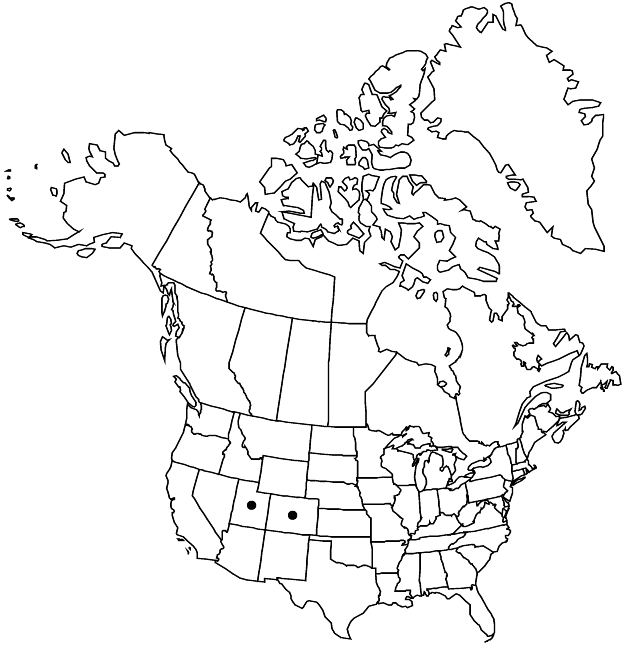Difference between revisions of "Eriogonum batemanii"
Contr. W. Bot. 11: 11. 1903.
FNA>Volume Importer |
imported>Volume Importer |
||
| (5 intermediate revisions by one other user not shown) | |||
| Line 24: | Line 24: | ||
|elevation=1400-2600 m | |elevation=1400-2600 m | ||
|distribution=Colo.;Utah. | |distribution=Colo.;Utah. | ||
| − | |discussion=<p>Eriogonum batemanii is fairly common throughout its range in northwestern Colorado (Moffat and Rio Blanco counties) and east-central Utah (Carbon, Duchesne, Emery, Garfield, Grand, and Uintah counties). In Duchesne County it hybridizes with E. shockleyi, producing an unnamed but distinctive hybrid.</p> | + | |discussion=<p><i>Eriogonum batemanii</i> is fairly common throughout its range in northwestern Colorado (Moffat and Rio Blanco counties) and east-central Utah (Carbon, Duchesne, Emery, Garfield, Grand, and Uintah counties). In Duchesne County it hybridizes with <i>E. shockleyi</i>, producing an unnamed but distinctive hybrid.</p> |
|tables= | |tables= | ||
|references= | |references= | ||
| Line 33: | Line 33: | ||
-->{{#Taxon: | -->{{#Taxon: | ||
name=Eriogonum batemanii | name=Eriogonum batemanii | ||
| − | |||
|authority=M. E. Jones | |authority=M. E. Jones | ||
|rank=species | |rank=species | ||
| Line 48: | Line 47: | ||
|publication year=1903 | |publication year=1903 | ||
|special status= | |special status= | ||
| − | |source xml=https:// | + | |source xml=https://bitbucket.org/aafc-mbb/fna-data-curation/src/2e0870ddd59836b60bcf96646a41e87ea5a5943a/coarse_grained_fna_xml/V5/V5_520.xml |
|subfamily=Polygonaceae subfam. Eriogonoideae | |subfamily=Polygonaceae subfam. Eriogonoideae | ||
|genus=Eriogonum | |genus=Eriogonum | ||
Latest revision as of 23:11, 5 November 2020
Herbs, spreading, not scapose, (1–)1.5–3.5(–5) × 1–2.5 dm, glabrous, grayish. Stems spreading, usually without persistent leaf bases, up to 1/4 height of plant; caudex stems absent; aerial flowering stems erect, slender, solid, not fistulose, 1–2 dm, glabrous. Leaves basal, 1 per node; petiole 0.8–2.5(–4) cm, tomentose; blade elliptic, (1–)1.5–3(–5) × 0.6–1(–1.2) cm, densely white-tomentose abaxially, less so and white adaxially, margins plane. Inflorescences cymose, 4–15 × 5–15 cm; branches dichotomous, glabrous; bracts 3, scalelike, triangular, 1–2 mm. Peduncles absent. Involucres (1–)2–5 per cluster, turbinate, 2–4 × 1.5–2.5(–3.5) mm, glabrous; teeth 5, erect, 0.5–0.8 mm. Flowers 1.5–3 mm; perianth white, glabrous; tepals connate proximally, monomorphic, obovate; stamens exserted, 1.5–3.5 mm; filaments sparsely pilose proximally. Achenes light brown to brown, 2.5–3 mm, glabrous. 2n = 40.
Phenology: Flowering Jun–Sep.
Habitat: Shaley, silty, gravelly, or clayey flats, washes, and slopes, saltbush and sagebrush communities, juniper woodlands
Elevation: 1400-2600 m
Discussion
Eriogonum batemanii is fairly common throughout its range in northwestern Colorado (Moffat and Rio Blanco counties) and east-central Utah (Carbon, Duchesne, Emery, Garfield, Grand, and Uintah counties). In Duchesne County it hybridizes with E. shockleyi, producing an unnamed but distinctive hybrid.
Selected References
None.
